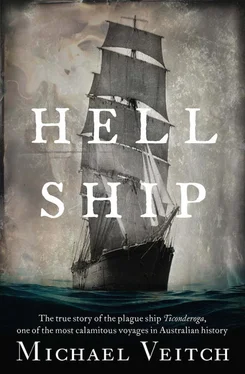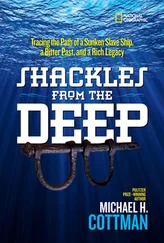Poring over their dimensions and sailing records, the Board discovered, to its considerable relief, that not only did these big new ships conform to British statutory regulations regarding the movement of assisted passengers, but that the mortality rate on board was in fact slightly lower than on smaller vessels. In addition, the Americans themselves—having experienced the boom time of emigration with the California gold fever—were now keen to revisit their success in this new rush to Australia, and were preparing to expand their reach with several large and new clippers. The economics added up as well. Whereas a smaller vessel that could offer more comfortable accommodation needed a higher number of privately paying passengers to make a profit, the larger ships’ economies of scale could still make a tidy sum crowding a greater number into one large class.
When the Board’s assessors did the figures, it was realised that some of these ships were capable of carrying close to a thousand people at time. Here, however, they had reason to pause. They were experienced in transporting numbers in the hundreds, sometimes up to 500 in a single vessel, but given the ever-present hoodoo of disease at sea, how feasible would it be to transport up to double those numbers at once? Plying back and forth across the Atlantic on voyages of a couple of weeks’ duration was one thing; two or three months or more at sea travelling to the opposite side of the globe was a far more daunting prospect.
Whatever reservations the Board may have had about commissioning such large vessels, no fewer than four were nevertheless invited to tender, and all four were quickly accepted and the leases drawn up. They were the 1300-ton Wanata , virtually new from her builder’s yard in New Brunswick; the 1495-ton German-owned Borneuf ; the enormous 1625-ton Marco Polo— in fact, a triple-decked ship—and, the smallest as well the last to tender, the Ticonderoga . In 1852, each of these ships would make their way, heavily laden with passengers, to Victoria.
Anticipating the rush in demand to emigrate, the imperial government passed An Act to Amend and Consolidate the Laws Relating to the Carriage of Passengers by Sea 1852, known otherwise as simply the Passengers Act , setting out specific standards of accommodation, victualling and accountability with which British passenger ships were bound to comply. The new regulations stated, among other things, that every passenger be issued three quarts of water daily; sleeping berths should be not less than 6 feet in length and 18 inches in width, and that a complete and detailed list, the Master’s List, be made of each embarking passenger.
Once the owners of the Ticonderoga signed the contract, her master, Captain Boyle, informed the Board that she would indeed be capable of accepting the maximum number of 630 ‘statue adults’ legally permitted for her tonnage, at a cost to the Board of £17 each, undercutting the next nearest quote of £18, 17s and 6d. What constituted a ‘statue adult’, however, is—like tonnage—somewhat complicated. It was defined by the Passengers Act as being any passenger over fourteen years of age, or any two under fourteen. Infants less than one year old—and on the Ticonderoga there were many of those—did not count at all. This partially accounts for the uncertainty surrounding the exact number of individuals who boarded the Ticonderoga at Birkenhead. Official statistics differ. According to the Victorian Health Officer’s report written after the voyage, there were 811, whereas the British Parliamentary Papers state 797. The Ticonderoga ’s own passenger records state a total of 814. Whatever the exact figure, it represented a sound profit for her owners who would receive half the per head fee on embarkation, the other half on arrival.
Deep within the bowels of the British Public Record Office in Kew, just outside London, a list of ships chartered by the Board still exists. Despite the passing of more than a century and a half, the Ticonderoga ’s contract remains in excellent condition, its terms laid out in the superb steel-nib copperplate handwriting of the day:
‘Ticonderoga’: Tonnage 1280: Colony—Melbourne:
Contract Price—£17:0:0
Date to be ready—26 July (1852) Birkenhead
Date of Departure—4 August (1852), Birkenhead
Brokers—Lindsay
Surgeons—J.C. Sanger, J.W.H. Veitch [2] British Public Record Office, List of Ships Chartered by the Land and Emigration Commission, CO 386/179, Folio 7
It goes on to break down the embarking emigrants into categories: 160 married men and an equal number of married women; 106 single females but only 68 single males; 126 boys under fourteen; 147 girls under fourteen. The manifest also mentions nationality: 140 English, 643 Scots, but only a handful of Irish—just fourteen. The quoted tonnage (which as stated varies in other sources) of 1280 conforms roughly to the permitted amount of statue adults, entered in the contract as ‘630½’. Underneath this figure, however, is a small but neat pencil mark reading ‘598’, undated, and with no other reference or explanation. Perhaps an official in the Board sensed, presciently, that at 630—a figure that in fact translated to several hundred more actual living souls—the Ticonderoga would be seriously over-crowded.
By the third day at the Birkenhead emigration depot, the anticipation brewing among the hundreds of emigrants soon due to depart on the Ticonderoga was palpable. For people used to the quiet routine of rural village life, the past few days had been a whirlwind.
However, after three days of meals delivered and eaten around their individual ‘mess’ table with fourteen or so complete strangers, then being required to scour and clean their own utensils; of every morning having to roll up their bedding and sweep out their berths; of being interviewed by the imposing Captain Patey and found to be of ‘good character’; of being medically examined and found fit to travel, they were—ready or not—about to face the great journey of many weeks at sea. The average age of the emigrants was somewhere around the mid-twenties, and at this stage the impending voyage still had the qualities of a great adventure: breathlessly anticipated, but utterly unknowable.
The depot only had space for around 400 at a time, but the Ticonderoga would be carrying twice that number, so a complicated loading timetable was drawn up lasting several days as groups of passengers underwent their processing. At this stage, the democracy of the depot began to come into question. The first to be loaded were the English, all 140 of them, mainly from Somerset and Gloucestershire, who by virtue of their birth right were given the best bunks towards the relatively stable stern of the ship. Next were loaded the Scots, then finally the Irish, who crowded into the poorer quarters in the bow.
Captain Thomas Boyle was proud of his ship, as he was of his contract to carry emigrants to Australia, and the responsibility that entailed. To prepare the Ticonderoga for the longest voyage it had undertaken as well as the largest number of people it had carried, he expended considerable effort and no small expense employing a small army of ship’s carpenters to reconfigure her interior, with a view to achieving the highest possible standards of comfort and hygiene for his passengers. To this end, a number of features had been included. First, no less than twenty newly designed flushing water-closets—toilets—for both male and female passengers were installed at strategic positions on the upper deck. At a time when such innovations were only just beginning to appear in the newest London houses, this was indeed a significant advance on the traditional ship’s ‘heads’, in which people had to position themselves over a hole in a wooden board jutting out from the side of the ship suspended precariously above the water. Instead, the Ticonderoga ’s modern devices used gravity-fed seawater tanks to flush away waste, which had to be manually pumped full every day. It was undoubtedly the first time anyone on board had seen anything like them. Another was the inclusion of four lead-lined bath tubs, each measuring a generous 6 feet by 2 feet. Admittedly, they could only be filled with salt water (stores of freshwater would be strictly used only for drinking and cooking), and would be used exclusively by the ship’s male population, but they were an advancement nonetheless.
Читать дальше












